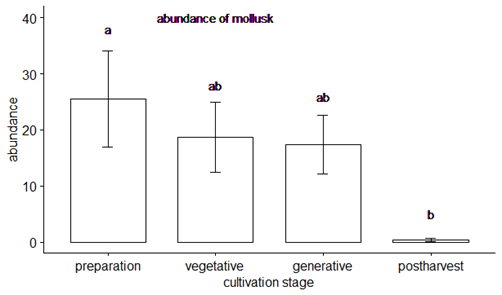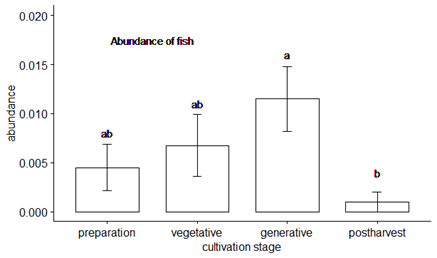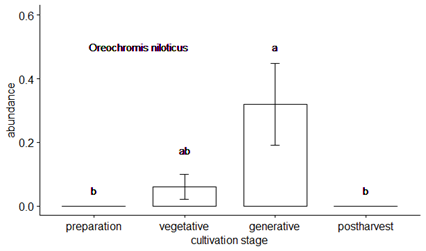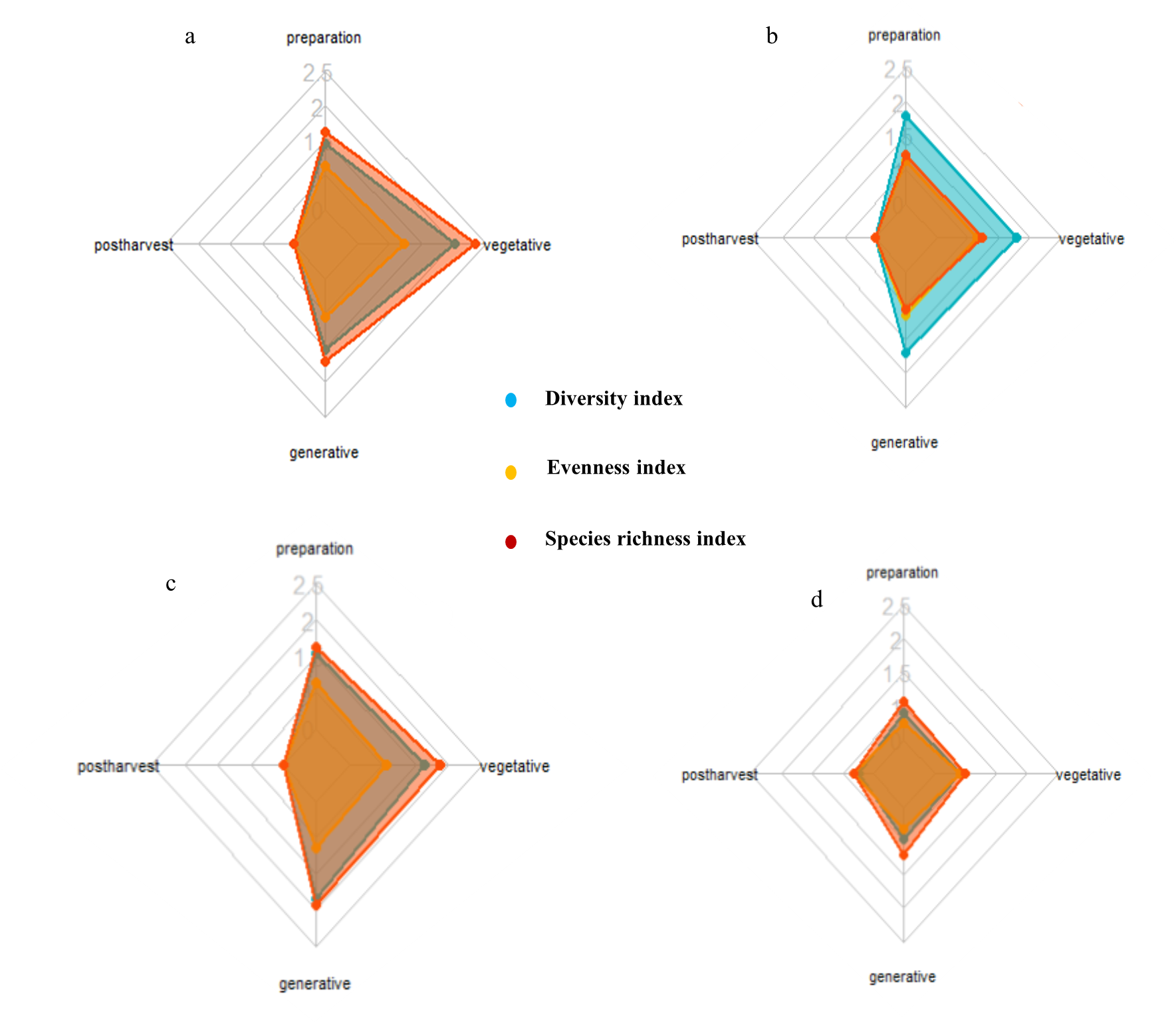IUCN/SSC Otter Specialist Group Bulletin

©IUCN/SCC Otter Specialist Group
Volume 40 Issue 2 (April 2023)
Citation: Andeska, F., Novarino, W., Nurdin, J., and Aadrean (2023). An Ecological Study of the Prey of the Otter in an Asynchronous Paddy Field Landscape. IUCN Otter Spec. Group Bull. 40 (2): 96 - 108
An Ecological Study of the Prey of the Otter in an Asynchronous Paddy Field Landscape
Ferdi Andeska1*, Wilson Novarino2, Jabang Nurdin2, and Aadrean2
1Berang-Berang Indonesia, Indonesia
2Biology Department of Andalas University, West Sumatra, Indonesia
*Corresponding Author Email: andeskaf@gmail.com
Received 27th November 2022, accepted 1st February 2023
Abstract: Otters are the top predators in wetlands. Otters have an essential ecological role in preserving the species richness of their food web. The availability of prey species in the habitat influences otter prey selection. Because of the cultivation stage, paddy fields in the tropical area have a distinct temporal seasonality. Consequently, information on the prey species of otter temporarily availability in Paddy field settings is essential for developing wildlife-friendly agricultural techniques. From January to April 2020, researchers studied the ecology of otters’ prey in rice fields in West Sumatra. We examined the ecological indexes of otters’ prey and whether cultivation stages influence the availability of otters' prey. Fish, snails, frogs, and water insects were the prey species studied in four cultivation stages. Ecological indices such as diversity index (H"), evenness index (E), and species richness index (R) are used to compare the findings of each type of otter prey. The ecological index values of the prey animals obtained by otters varied quite a lot depending on the type of prey and the growing season. The abundance of snails, the number of snails, the abundance of fish and the abundance of Oreochromis nilloticus were significantly different across cultivation stages (P<0.05) according to the results of the ANOVA test. The asynchronous paddy field system is suitable for providing otters with abundant prey all year round. Therefore it will be used to create an otter-friendly rice field landscape.
Keywords: diversity; abundance; latrine site; top predator
INTRODUCTION
Paddy fields are artificial wetland ecosystem very useful for human life as food producers. Paddy fields are also stagnant water ecosystems that support the life of various aquatic animals and plants. The paddy field ecosystem has a high diversity of fauna. Various types of fauna are native inhabitants of paddy field habitats, and humans intentionally introduce some for cultivation purposes (Puspita et al., 2005). Paddy field cultivation activities can regulate the abundance and diversity of aquatic insect organisms (Asghar, 2010; Che Salmah and Abu Hassan, 2002; Hayasaka et al., 2012; Mogi, 2007). Paddy field cultivation is divided into multiple stages during the cultivation process (Fernando, 1993), resulting in variations in the composition of aquatic insects in different phases (Che Salmah et al., 1998). Other organisms in the paddy fields outside aquatic insects include wild plants, plankton, several types of bacteria, rodents, and water snakes (Lu et al., 2002). The interaction of these organisms produces a balanced ecosystem, providing paddy fields with an ideal environment for various species (Deb, 2009). It has otters, the primary predators of the rice field landscape.
The otter is one of the species that are dependent on the existence of wetlands (Asmoro et al., 1994). They are the top predators in their habitat. Otters are essential in maintaining the balance of animal abundance in their ecosystems (Foster-Turley & Santiapillai, 1990). Otters primarily consume fish, although each species has varied dietary preferences (Anoop and Hussain, 2005; Kasper et al., 2008). Indonesia has four otter species out of the world's thirteen. These are Aonyx cinereus (Illiger, 1815), Lutra sumatrana (Gray, 1865), Lutrogale perspicillata (Geofroy Saint-Hilaire, 1826) and Lutra lutra (Linnaeus, 1758). (Corbet and Hill, 1992). Only A. cinereus is not protected by the Regulation of the Minister of Environment and Forestry of the Republic of Indonesia.
Small-clawed otters (A. cinereus) are widespread throughout South and Southeast Asia. The International Union for Conservation of Nature (IUCN) Red List has categorized them as vulnerable species (Wright et al., 2015). Rivers, peat swamps, mangroves, paddy fields, ditches, and fish ponds are among the natural and artificial habitats used by small-clawed otters (Hussain et al., 2011). Small-clawed otters forage in paddy fields and use those as latrines in several Southeast Asian contries, including Malaysia, Thailand, the Philippines, and Indonesia (Foster-Turley, 1992; Aadrean et al., 2010; Gonzalez, 2010; Kanchanasaka and Duplaix, 2011). In the Malaysian Peninsula, otter latrine sites were discovered in paddy fields near mangrove muck (Foster-Turley, 1992). While conducting a preliminary study on the occurrence of small-clawed otters (Aadrean et al., 2010) and their feeding characteristics (Aadrean et al., 2011), it was discovered that they utilize a paddy field near the settlement for foraging and as a latrine site.
The diet of small-clawed otters has been previously studied with the composition of the diet having aquatic animals such as crabs, fish, frogs, arthropods, mammals, and snails in natural wetlands dominated by crabs (Kruuk et al., 1994; Hon et al., 2010) While in artificial wetlands such as paddy fields, fish dominate (Andeska et al., 2021). The difference is influenced by prey availability in their habitat (De Silva, 1991). In the present study the researchers wanted to reveal the effect of different stages of paddy-field cultivation on the prey abundance of small-clawed otters. Previous studies, several related to the ecology of otters, have been carried out to examine the influence of spatial and temporal characteristics on visits to latrine sites (Aadrean and Usio, 2017; 2020) and temporal environmental factors on the diet of otters in paddy fields (Andeska et al., 2021). The results of this study can complement previous research to develop the basis for creating a paddy field cultivation system suitable for the survival of otters.
STUDY SITE AND METHODS
Study site
This research was carried out from January - April 2020. The research location was selected in the rice fields of Lubuk Alung sub-district, Padang Pariaman district, West Sumatra (longitude 0°38′00″S - 0°40′40″S, latitude 100°17′10″E - 100° 20′20″E), with an altitude of 25 - 50 m above sea level. The paddy field cultivation system is carried out individually by the owner of the paddy fields and the owner can determine the timing of his rice cultivation, thus creating heterogeneous rice fields (Aadrean and Usio, 2017).
The tools and materials used in this research are digital cameras, G.P.S., plastic bags, collection bottles, sticky labels, compound microscopes, ropes, petri dishes, dip nets, filters, electro-fishing instruments, fishing nets, flash lights, data sheets, 70% alcohol, and 4% and 10% formalin.
The Abundance of Otter Prey
This study uses quantitative methods and purposive sampling to determine the location of the selected planting season. The selected location should be close to the latrine site surveyed (Aadrean and Usio, 2017). We divided the cultivation stage into four categories: preparatory, vegetative, generative, and postharvest. The preparation stage is the period that starts from the time the fields are ploughed until the farmers plant rice seeds. The vegetative stage is when farmers start planting rice until the emergence of rice flowers. The generative stage starts from flowering until the farmer harvests the rice. Postharvest is the period after harvesting until the land is ploughed again (Andeska et al., 2021).
At every cultivation stage, we collected prey animals of small-clawed otter such as insects, Molluscs, Fishes, and frogs. The limitation of the animals collected is based on the research of Andeska et al. (2021). He used the category of prey animals that have an occurrence frequency above 10% in the diet of small-clawed otters in rice fields. The density of prey animals was calculated at each different rice growing season. Sampling was carried out in the rice field plots, and the dich closest to the rice field. Methods and efforts for taking samples were adjusted to taxa groups and rice growing season. Sampling at every cultivation stage was done at five different locations.
| Table 1: Prey animal survey methods and identification guidebooks used. | ||||
| No | Category | Method | Effort | Identification Guide |
| 1 | Insect | Dip Net | 20 cm x 500 cm | Merrit and Cummin, 1984 |
| 2 | Mollusc | Dip Net and Hand Sorting | 20 cm x 500 cm | Pennak,1978, Djajasasmita, 1999 |
| 3 | Fishes | Electrofishing | 200 m transect distance x 40 cm net width | Kottelat, et al.,1993 |
| 4 | Frog | Visual encounter survey | 200 m transect with 5 m left and right visibility | Inger and Stuebing, 2005 |
Data Analysis
We calculated the abundance of prey for the small-clawed otter at each cultivation stage. The number of species and density of otter prey categories in each cultivation stage was also calculated. Using this data ecological indices, such as the Shannon-Wiener diversity index (H'), evenness index (E), and Margalef species richness index (R), were calculated to compare community patterns in each cultivation stage. In addition, the one-way ANOVA test and Tukey's test were conducted to see the effect of different cultivation stages on the prey abundance of the Small-clawed otter.
RESULTS
A wide variety of prey items were identified (Table 2, Table 3).
Based on the observations of otter prey in the paddy fields, it was found that the most common prey category was Molluscs during the preparation stage (N: 1020; Table 3), which was dominated by the species L. rubiginosa. While for the category of Fishes most commonly found during the generative stage, namely 45 individuals with a total of 8 species (Table 3), the most common species found was O. niloticus (16; Table 2). Furthermore, for the amphibian category, the highest number of individuals was found in the preparation stage, and insects in the vegetative stage (Table 3), dominated by the species F. cancrivora for frog prey and Cullicoides for insect prey (Table 2). The prey density of otters observed shows that the number of individuals changes according to the cultivation stage. The number of individuals appears to be high if the environmental factors of the cultivation stage support the presence of otter prey.
Based on Figure 1, the ecological index values calculated varied depending on the cultivation stage and the type of prey category. The highest biodiversity index of insects, evenness index, and species richness index were in the vegetative stage (H′: 1.94, E: 0.93, R: 2.64), while for the snails, the highest biodiversity index was in the preparation stage (H′:1.64), the highest evenness index was during the generative stage (E: 0.85), and the species richness index was during the vegetative stage (R: 0.91). The highest ecological index for the Fishes category is the generative stage (H′: 1.73, E: 0.83, R: 1.84),whereas for the frog, the highest biodiversity index was in the generative stage (H′: 0.6), the evenness index (E: 0.49), and the species richness index in the generative stage (R: 0.93). Frogs have the smallest ecological index value for the prey category compared to other prey categories, while insects have the highest ecological index.
We split the dependent variable into three levels in the ANOVA test: the abundance of otter diet categories, the number of species from each prey category, and the abundance of each prey species collected. Of the four abundance categories of prey, only two were impacted by the cultivation stage in the ANOVA test of the effect of Molluscs and Fishes (P<0.05; Table 4). For the number of species of prey, only Mollusc was affected by the cultivation stage (P<0.05; Table 4). Meanwhile, only O. niloticus was shown to be influenced by the cultivation stage in terms of otter prey quantity (P<0.05; Table 4).
DISCUSSION
The diversity index categorizes the features of insects, snails, and fish as moderate. The highest insect diversity index occurs during the vegetative stage because it may provide shaded conditions that aquatic insects prefer (Norela et al., 2013). Paddies are essential for insects that reproduce in shallow water. Flooded paddy fields are frequently rich in algae, plankton, and other aquatic insect food (Roger et al., 1991). During growth from the tiller stage to the adult stage of paddy or when the paddy plant is actively producing rice grains, the abundance of Disticidae and Odonata is more abundant (Che Salmah and Abu Hassan, 2002; Mogi and Miyagi, 1990). The ANOVA test results show that the difference in the cultivation stage does not affect the number of insects. This research discusses other characteristics that have a distinct impact on insects. Climate, geographical conditions, altitude, food type, insect spreadability, habitat selection, and food availability are all environmental elements that may impact bug prevalence (Tofani, 2008).
In the snail prey category, the highest diversity index was in the preparation stage (Figure 2), and the difference in the cultivation stage impacted the abundance and number of snail species (P<0.05; Table 4). If related to paddy growth, the number of molluscs increased in the initial processing phase, then stayed steady until 2-3 weeks before harvesting. According to Aadrean and Usio (2020), snails are most commonly found in rice fields that have been flooded, such as during the processing and vegetative periods. Figure 2 demonstrates that the cultivation stage that had the most significant impact on snail abundance was the preparation stage,while in Figure 3, the number of species of snails was found at the most in the generative stage. It was because when the paddy phase actively produces grains, it creates a suitable microhabitat for aquatic organisms to find food. The highest number of species and individuals of snail was generally found in paddy fields that are still waterlogged and soil is still slightly moist during one to two weeks of age of rice plants. In paddy fields with these conditions, sunlight penetration is still sufficient to reach the substrate because paddy plants have not blocked it.


On the other hand, fish abundance is influenced by the cultivation stage (Table 4; P=0.04*). Figure 4 shows the difference in the generative stage. Furthermore, among the ten taxa/species found, just O.niloticus abundance was affected by changes in the cultivation stage (Table 4; P=0.01*). Figure 5 illustrates the generative stage of O. niloticus with the greatest average abundance caused by water availability throughout the growing season, which is a determining factor for the survival of fish in rice fields. The number and diversity of fish will be high when fish can easily travel from the river/upstream to the rice fields since the paddy fields in this region use an irrigation system.


The diversity index of frogs in Lubuk Alung paddy fields generally includes low diversity (H′<1). It can be seen from the low evenness index of amphibians, which means that the distribution of species in each cultivation stage was uneven. Of all cultivation stages, the preparation stage has the highest diversity value. Naturally, frogs will be highly abundant when the rice is still young because there is still a lot of water available, and it inundates all land surfaces of the paddy fields. Their abundance will decrease as water supply decreases and the age of paddy plants. Differences in the cultivation stage also did not affect the abundance and number of frog species in the study area. It was because other independent factors, such as surface water temperature, can affect the abundance of frogs. Kurniati (2017) stated that environmental factors in the form of surface water temperature affects the individual density of frogs and pre-adults of frogs (F. cancrivora).
In the natural habitat of paddy fields, small-clawed otters prey on fish, snails, insects, frogs, reptiles, crustaceans, birds, and mammals. Fish and molluscs were the most dominant prey hunted by small-clawed otters (Andeska et al., 2021). That was interesting because the cultivation stage influenced the abundance of small-clawed otter prey according to this study. In the research of Andeska et al. (2021), the selection of snails as prey was influenced by the water level in the paddy fields, and any environmental factors did not influence the selection of fish as prey. The results of this study can support the conclusion of Aadrean and Usio (2020), which states that small-clawed otters prefer the vegetative stage as a foraging area.
CONCLUSION
The existence of an asynchronous paddy field system throughout the year can maintain the availability of prey for small-clawed otters. If the paddy fields use a simultaneous planting system, it will result in otters experiencing food shortages (Aadrean and Usio, 2020). Therefore, applying the paddy cultivation system and paying attention to aspects of food security also needs to consider conservation aspects so that the existence of the small-clawed otter is not increasingly threatened. Therefore, it is necessary to have a sustainable rice cultivation that can increase the environment’s carrying capacity to support the lives of present and future generations.
Acknowledgements: We want to thank Muhammad Akbar, Hahafi Ma’ruf, Team Verteb Andalas University, and all Museum Zoology Andalas University members. This study was funded by Andalas University (contract number T/49/UN.16.17/PT.01.03-IS-RD/2020).
REFERENCES
Aadrean, and Usio, N. (2017). Small-clawed otters (Aonyx cinereus) in Indonesian rice fields: latrine site characteristics and visitation frequency. Ecological Research, 32: 899-908 https://doi.org/10.1007/s11284-017-1496-6
Aadrean, and Usio, N. (2020). Spatiotemporal patterns of latrine-site use by small-clawed otters in a heterogeneous rice field landscape. Mammal Study 45: 103–110 https://doi.org/10.3106/ms2019-0031
Aadrean, Novarino, W., and Jabang, (2011). A record of small-clawed otters (Aonyx cinereus) foraging on an invasive pest species, golden apple snails (Pomacea canaliculata) in a West Sumatra rice field. IUCN Otter Specialist Group Bulletin, 28(1): 34–38. https://www.iucnosgbull.org/Volume28/Aadrean_et_al_2011.html
Aadrean, Salmah, S., Salsabila, A., and Janra, R.M.N. (2010). Tracks and other signs of otters in rice fields in Padang Pariaman, West Sumatra: a preliminary study. IUCN Otter Spec Group Bull, 27:6–11. https://www.iucnosgbull.org/Volume27/Aadrean_et_al_2010.html
Andeska, F., Novarino, W., Nurdin, J. and Aadrean (2021). Relationship between Temporal Environment Factors and Diet Composition of Small-Clawed Otter (Aonyx cinereus) in Heterogeneous Paddy Fields Landscape in Sumatra, Indonesia. IUCN Otter Spec. Group Bull. 38 (2): 106 - 116 https://www.iucnosgbull.org/Volume38/Andraska_et_al_2021.html
Anoop, K.R., Hussain, S.A. (2005). Food and feeding habits of smooth-coated otters (Lutra perspicillata) and their significance to the fish population of Kerala, India. Journal of Zoology, 266, 15-23. https://doi.org/10.1017/S095283690500654
Asghar, M. (2010). Biodiversity of Insects Associated with Rice (Oryza sativa L.) Crop Agroecosystem in Punjab, Pakistan. PhD. Thesis. University of Agriculture, Faisalabad, Pakistan.
Asmoro, P.D., Melisch, R., Kusumawardhanio, (1994). Hubungan antara Berang-Berang dengan Manusia. Simposium Pertama Mengenai Berang-Berang di Indonesia. Bogor. 7 April 1994.
Che Salmah, M.R., A. Abu Hassan, A. (2002). Distribution of aquatic insects in relation to rice cultivation phases in a rain fed rice field. Jurnal Biosains 13: 87–107.
Che Salmah, M.R., Hassan, S.T.S., Abu Hassan, A., Ali, A.B. (1998). Influence of physical and chemical factors on the larval abundance of Neurothemis tullia (Drury) (Odonata: Libellulidae) in a rain fed rice field. Hydrobiologia 389: 193–202. https://doi.org/10.1023/A:1003511227253
Corbet, G.B., Hill, J.E. (1992). The Mammals of the Indomalayan Region, A Systematic Review. Natural History Museum Publications. Oxford University Press. New York.
De Silva, P.K. (1991) Distribution of Lutra lutra in the Highlands of Sri Lanka IUCN Otter Spec. Group Bull. 6: 2-5 https://www.iucnosgbull.org/Volume6/De_Silva_1991.html
Deb, D. (2009). Biodiversity and Complexity of Rice Farm Ecosystems : An Empirical Assessment. The Open Ecology Journal, 2: 112–129. http://dx.doi.org/10.2174/1874213000902010112
Djajasasmita, M. (1999). Keong dan kerang sawah [Rice Field Snails and Slugs]. Puslitbang Biologi-LIPI, Bogor. 57pp
Fernando, C.H. (1993). Rice field ecology and fish culture – an overview. Hydrobiologia 259: 91-113. https://doi.org/10.1007/BF00008375
Foster-Turley, P. (1992). Conservation aspects of the ecology of Asian small-clawed and smooth coated otters on Malay peninsula. IUCN Otter Spec. Group Bull. 7: 26 -29 https://www.iucnosgbull.org/Volume7/Foster_Turley_1992.html
Foster-Turley, P., C. Santiapillai. (1990). Action plan for Asian otters, In Otters, an action plan for their conservation (Eds.) Pat Foster-Turley, Sheila Macdonald and Chris Mason. IUCN/SSC, Otter Specialist Group, Gland. 126 pp.
Gonzalez, J.B. (2010). Distribution, exploitation and trade dynamics of Asian small-clawed otter (Amblonyx cinereus) Illiger 1815 in Mainland Palawan, Philippines. Thesis. Western Philippines University.
Hayasaka, D., Korenaga, T., Sanchez Bayo, F., Goka, K. (2012). Differences of ecological impact of systemic insecticide with difference physicochemical properties on biocenosis of experimental paddy fields. Ecotoxicology 21: 191–201. https://doi.org/10.1007/s10646-011-0778-y
Hon, N., Neak, P., Khov, V., Cheat, V. (2010). Food and habitat of Asian small-clawed otter in northeastern Cambodia. IUCN Otter Spec Group Bull 21:12–23. https://www.iucnosgbull.org/Volume27/Hon_et_al_2010.html
Hussain, S.A., Gupta, S.K., De Silva P.K. (2011). Biology and ecology of Asian small-clawed otter Aonyx cinereus (Illiger, 1815): a review. IUCN Otter Spec Group Bull 28: 63–75. https://www.iucnosgbull.org/Volume28/Hussain_et_al_2011.html
Inger, R.F., and Stuebing, R.B. (2005). A Field Guide to the Frogs of Borneo. 2nd Edition. Natural History Publications (Borneo),Malaysia. 209 pp. ISBN 978-9838120852
Kanchanasaka, B. and Duplaix, N. (2011). Food Habits of the Hairy-nosed otter (Lutra sumatrana) and the Small-clawed otter (Aonyx cinereus) in Pru Toa Daeng Peat Swamp Forest, Southern Thailand. Proceedings of Xth International Otter Colloquium, IUCN Otter Spec. Group Bull. 28A: 139 - 161 https://www.iucnosgbull.org/Volume28A/Kanchanasaka_Duplaix_2011.html
Kasper, C.B., Bastazini, V.A.G., Salvi, J., Grillo, H.C.Z. (2008). Trophic ecology and the use of shelters and latrines by the Neotropical otter (Lontra longicaudis) in the Taquari Valley, Southern Brazil. Iheringia, Sér. Zool., Porto Alegre. 98: 469-474 https://doi.org/10.1590/S0073-47212008000400009
Kottelat, M., A.J. Whitten, S.N. Kartikasari and S. Wirjoatmodjo, (1993). Freshwater fishes of Western Indonesia and Sulawesi. Periplus Editions, Hong Kong. 221 pp
Kruuk, H., Kanchanasaka, B., O'Sullivan, S., Wanghongsa, S. (1994). Niche separation in three sympatric otters Lutra perspicillata, L. lutra and Aonyx cinereus in Huai Kha Khaeng, Thailand. Biol. Conserv. 69: 115-120. https://doi.org/10.1016/0006-3207(94)90334-4
Kurniati, H., Sulistyadi, E. (2017). Kepadatan Populasi Kodok Fejervarya cancrivora Di Persawahan Kabupaten Kerawang, Jawa Barat. Journal Biologi Indonesia, 13: 71-82. http://dx.doi.org/10.14203/jbi.v13i1.3097
Lu, Y., Watanabe, A. and Kimura, M. (2002). Contribution of plant-derived carbon to soil microbial biomass dynamics in a paddy rice microcosm. Biol Fertil Soils 36: 136–142. https://doi.org/10.1007/s00374-002-0504-2
Merrit, R.W. and Cummins, K.W. (1984). An introduction to the aquatic insects of North America. Kendall\Hunt Publishing Company. ISBN : 9780840331809
Mogi, M. (2007). Insect and other invertebrate predators. J. of the American Mosquito Control Association, 23: 93-109 (2007). https://doi.org/10.2987/8756-971X
Mogi, M., Miyagi, I. (1990). Colonization of rice fields mosquitoes (Diptera: Culicidae) and larvivorous predators in asynchronous rice cultivation areas in the Philippines. Journal of Medical Entomology 27: 530-536. https://doi.org/10.1093/jmedent/27.4.530
Norela, S., I. Anizan, B. S. Ismail & A. Maimon. (2013). Diversity of pest and non-pest insects in an organic paddy field cultivated under the System of Rice Intensification (S.R.I.): A case study in Lubok Chia, Melaka, Malaysia. Journal of Food, Agriculture and Environment 11: 2861-2865
Pennak, R. W. (1978). Freshwater Invertebrates of the United States. John Wiley & Sons. 803 pp. ISBN: 978-0-471-35837-4
Puspita, L., Ratnawati, E., Suryadiputra, I.N., Meutia, A.A. (2005). Lahan Basah Buatan di Indonesia. Wetland International-Indonesia Programme.
Roger, R.A., Heong, K.L., Teng, R.S. (1991). Biodiversity and sustainability of wetland rice production: role and potential of microorganisms and invertebrates. In: Hawksworth, D.L. (Ed.), The Biodiversity of Microorganisms and Invertebrates: Its Role in Sustainable Agriculture. C.A.B. International, Silwood Park, Ascot, pp. 117-136
Tofani, D.P. (2008). Keanekaragaman serangga di hutan alam resort Cibodas, Gunung Gede pangrango dan hutan tanaman jati di KPH Cepu [skripsi]. Fakultas Kehutanan, Institut Pertanian Bogor
Wright, L., de Silva, P., Chan, B., Reza Lubis, I. (2015). Aonyx cinereus. The IUCN Red List of Threatened Species 2015: eT44166A21939068.
https://dx.doi.org/10.230 5/IUCN.UK.20152.LTS.T44166A21 939068.
Résumé: Étude Écologique des Proies des Loutres dans un Paysage Asynchrone de Rizières à l’Ouest de Sumatra
Les loutres sont les principaux prédateurs des zones humides. Les loutres ont un rôle écologique essentiel dans la préservation de la richesse spécifique de leur réseau trophique. La disponibilité des espèces de proies dans l'habitat influence la sélection des proies des loutres. En fonction du stade de culture, les rizières de la zone tropicale ont une saisonnalité temporelle distincte. Par conséquent, les informations sur les espèces de proies de loutre temporairement disponibles dans les rizières sont essentielles pour développer des techniques agricoles respectueuses de la faune. De janvier à avril 2020, des chercheurs ont étudié l’écologie des proies des loutres dans les rizières de l’ouest de Sumatra. Nous avons examiné les indices écologiques des proies des loutres afin de voir si les stades de culture influencent la disponibilité en proies des loutres. Nous avons étudié les espèces de proies suivantes : les poissons, les escargots, les grenouilles et les insectes aquatiques, à quatre stades différents de culture. Des indices écologiques tels que l’indice de diversité (H), l’indice d’uniformité (E) et l'indice de richesse spécifique (R) sont utilisés pour comparer les résultats de chaque type de proie de loutre. Les valeurs de l’indice écologique des proies obtenues pour les loutres variaient fortement selon le type de proie et la saison de culture. Selon les résultats du test ANOVA, l’abondance d’escargots, le nombre d’escargots, l’abondance de poissons et de tilapia du Nil (Oreochromis niloticus) étaient significativement différents suivant le stade de culture (P<0,05). Le système de rizière asynchrone est donc adapté pour fournir aux loutres des proies abondantes tout au long de l’année. En conséquence, il sera utilisé pour créer un paysage de rizières respectueux des loutres..
Revenez au dessus
Resumen: Estudio Ecológico de las Presas de la Nutria en un Paisaje Asincrónico de Arrozal
Las nutrias son los predadores tope en los humedales. Las nutrias tienen un rol ecológico esencial en la preservación de la riqueza de especies de su red alimenticia. La disponibilidad de especies-presa en el hábitat influencia la selección de presas por la nutria. A causa del estadío del cultivo, los arrozales en el área tropical tienen una clara estacionalidad temporal. Consecuentemente, la información sobre la disponibilidad temporal de las especies-presa de la nutria en contextos de Arrozal es esencial para desarrollar técnicas agrícolas compatibles con la fauna. Entre Enero y Abril de 2020, estudiamos la ecología de las presas de la nutria en arrozales en Sumatra Occidental. Examinamos los índices ecológicos de las presas de la nutria, y si los estadíos del cultivo influencian la disponibilidad de presas. Las especies-presa estudiadas en cuatro estadíos de cultivo, fueron peces, caracoles, ranas, e insectos acuáticos. Usamos índices ecológicos como el índice de diversidad (H′), índice de equitatividad (E), e índice de riqueza de especies (R), para comparar los hallazgos de cada tipo de presa. Los valores de los índices ecológicos de las presas animales obtenidas por las nutrias, variaron considerablemente, dependiendo del tipo de presa y la estación de crecimiento. La abundancia de caracoles, el número de caracoles, la abundancia de peces y la abundancia de Oreochromis niloticus fueron significativamente diferentes en el estadío de cultivo (P<0.05), de acuerdo a los resultados del test ANOVA. El sistema de arrozal asincrónico es adecuado para proveer a las nutrias con presas abundantes a lo largo de todo el año. Por lo tanto, será utilizado para crear un paisaje de arrozales compatible con las nutrias.
Vuelva a la tapa
Ringkasan: Kajian Ekologis Mangsa Berang-Berang di Landskap Sawah Asinkron
Berang-berang adalah predator teratas di lahan basah. Berang-berang memiliki peran ekologis yang penting dalam melestarikan kekayaan jenis rantai makanannya. Ketersediaan spesies mangsa di habitat mempengaruhi pemilihan mangsa berang-berang. Karena tahapan waktu budidaya, sawah di daerah tropis memiliki musim tahap yang berbeda. Konsekuensinya, informasi tentang spesies mangsa berang-berang yang tersedia sementara di sawah sangat penting untuk mengembangkan teknik pertanian ramah satwa liar. Dari Januari hingga April 2020, peneliti mempelajari ekologi mangsa berang-berang di persawahan di Sumatera Barat. Kami memeriksa indeks ekologi mangsa berang-berang dan apakah tahap budidaya mempengaruhi ketersediaan mangsa berang-berang. Ikan, siput, katak, dan serangga air merupakan spesies mangsa yang dipelajari dalam empat tahap budidaya. Indeks ekologi seperti indeks keanekaragaman (H′), indeks kemerataan (E), dan indeks kekayaan spesies (R) digunakan untuk membandingkan temuan setiap jenis mangsa berang-berang. Nilai indeks ekologi hewan mangsa yang diperoleh berang-berang cukup bervariasi tergantung jenis mangsa dan musim tanam. Kelimpahan keong, jumlah keong, kelimpahan ikan dan kelimpahan Oreochromis niloticus berbeda nyata pada tahap budidaya (P<0,05) menurut hasil uji ANOVA. Sistem sawah asinkron cocok untuk memberi berang-berang mangsa yang melimpah sepanjang tahun. Oleh karena itu akan digunakan untuk membuat lanskap sawah ramah berang-berang.
Kembali ke awal




